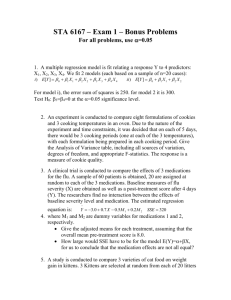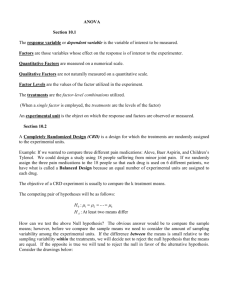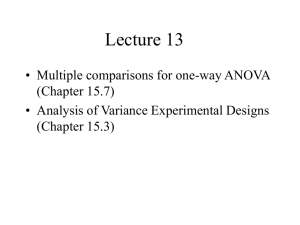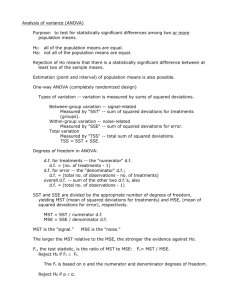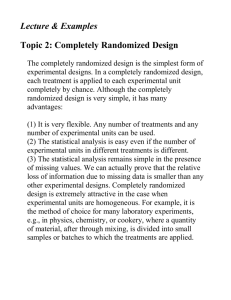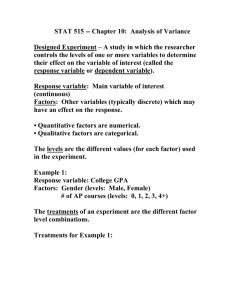Lecture 12 - Wharton Statistics Department
advertisement
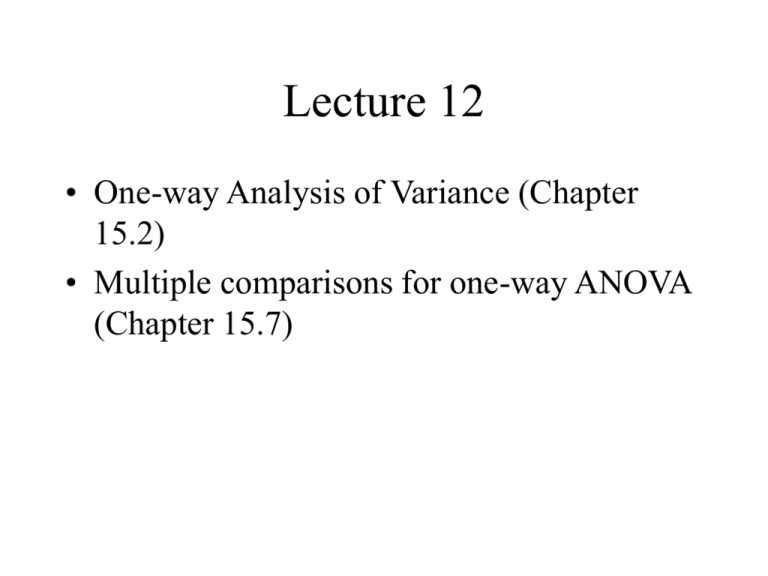
Lecture 12 • One-way Analysis of Variance (Chapter 15.2) • Multiple comparisons for one-way ANOVA (Chapter 15.7) Review of one-way ANOVA • Objective: Compare the means of K populations of interval data based on independent random samples from each. • H0: 1 2 K • H1: At least two means differ • Notation: xij – ith observation of jth sample; x j - mean of the jth sample; n – number of j observations in jth sample; x - grand mean of all observations Example 15.1 • The marketing manager for an apple juice manufacturer needs to decide how to market a new product. Three strategies are considered, which emphasize the convenience, quality and low price of product respectively. • An experiment was conducted as follows: • In three cities an advertisement campaign was launched . • In each city only one of the three characteristics (convenience, quality, and price) was emphasized. • The weekly sales were recorded for twenty weeks following the beginning of the campaigns. Rationale Behind Test Statistic • Two types of variability are employed when testing for the equality of population means – Variability of the sample means – Variability within samples • Test statistic is essentially (Variability of the sample means)/(Variability within samples) The rationale behind the test statistic – I • If the null hypothesis is true, we would expect all the sample means to be close to one another (and as a result, close to the grand mean). • If the alternative hypothesis is true, at least some of the sample means would differ. • Thus, we measure variability between sample means. Variability between sample means • The variability between the sample means is measured as the sum of squared distances between each group mean and the grand mean times the sample size of the group. This sum is called the Sum of Squares for Treatments In our example treatments are SST represented by the different advertising strategies. Sum of squares for treatments (SST) k SST n j ( x j x) 2 j 1 There are k treatments The size of sample j The mean of sample j Note: When the sample means are close to one another, their distance from the grand mean is small, leading to a small SST. Thus, large SST indicates large variation between sample means, which supports H1. Sum of squares for treatments (SST) • Solution – continued Calculate SST x1 577.55 x 2 653.00 x 3 608.65 k SST n j ( x j x) 2 j 1 The grand mean is calculated by n1 x1 n2 x 2 ... nk x k X n1 n2 ... nk = 20(577.55 - 613.07)2 + + 20(653.00 - 613.07)2 + + 20(608.65 - 613.07)2 = = 57,512.23 Sum of squares for treatments (SST) Is SST = 57,512.23 large enough to reject H0 in favor of H1? Large compared to what? 30 25 x3 20 20 x 2 15 16 15 14 11 10 9 x3 20 20 19 x 2 15 x1 10 12 10 9 x1 10 7 A small variability within the samples makes it easier Treatment 1 Treatment 2 Treatment 3 to draw a conclusion about the population means. The 1 sample means are the same as before, but the larger within-sample variability Treatment 1 Treatment 2 Treatment 3 makes it harder to draw a conclusion about the population means. The rationale behind test statistic – II • Large variability within the samples weakens the “ability” of the sample means to represent their corresponding population means. • Therefore, even though sample means may markedly differ from one another, SST must be judged relative to the “within samples variability”. Within samples variability • The variability within samples is measured by adding all the squared distances between observations and their sample means. This sum is called the Sum of Squares for Error SSE In our example this is the sum of all squared differences between sales in city j and the sample mean of city j (over all the three cities). Sum of squares for errors (SSE) • Solution – continued Calculate SSE s12 10 ,775 .00 s 22 7,238 ,11 s32 8,670 .24 k SSE nj (xij x j ) 2 (n1 - 1)s12 + (n2 -1)s22 + (n3 -1)s32 j 1 i 1 = (20 -1)10,774.44 + (20 -1)7,238.61+ (20-1)8,670.24 = 506,983.50 Sum of squares for errors (SSE) Is SST = 57,512.23 large enough relative to SSE = 506,983.50 to reject the null hypothesis that specifies that all the means are equal? The mean sum of squares To perform the test we need to calculate the mean squares as follows: Calculation of MST Mean Square for Treatments SST k 1 57 ,512 .23 3 1 28 ,756 .12 MST Calculation of MSE Mean Square for Error SSE nk 509 ,983 .50 60 3 8,894 .45 MSE The F test rejection region And finally the hypothesis test: H0: 1 = 2 = …=k H1: At least two means differ MST Test statistic: F MSE R.R: F>Fa,k-1,n-k The F test MST MSE 28,756.12 8,894.17 3.23 F Ho: 1 = 2= 3 H1: At least two means differ Test statistic F= MST/ MSE= 3.23 R.R. : F Fak 1nk F0.05,31,60 3 3.15 Since 3.23 > 3.15, there is sufficient evidence to reject Ho in favor of H1, and argue that at least one of the mean sales is different than the others. Required Conditions for Test • Independent simple random samples from each population • The populations are normally distributed (look for extreme skewness and outliers, probably okay regardless if each n j 30 ). • The variances of all the populations are equal (Rule of thumb: Check if largest sample standard deviation is less than twice the smallest standard deviation) ANOVA Table – Example 15.1 Analysis of Variance Source DF Sum of Squares Mean Square F Ratio Prob > F City 2 57512.23 28756.1 3.2330 0.0468 Error 57 506983.50 8894.4 C. Total 59 564495.73 Model for ANOVA • X ij = ith observation of jth sample • X a ij j ij • is the overall mean level, a j is the differential effect of the jth treatment and ij is the random error in the ith observation under the jth treatment. The errors are assumed to be independent, 2 normally distributed with mean zero and variance K The a j are normalized: j1a j 0 Model for ANOVA Cont. • The expected response to the jth treatment is E ( X ij ) a j • Thus, if all treatments have the same expected response (i.e., H0 : all populations have same mean), a j 0, for j 1,, K . In general, a j a j ' is the difference between the means of population j and j’. • MSE is estimate of Var ( ij ) 2 • Sums of squares decomposition: SS(Total)=SST+SSE Review Question: Intro to ANOVA • Which case does ANOVA generalize? – 2-sample mean comparison with equal variance assumption – 2-sample mean comparison with unequal variances permitted – 2-sample variance comparison Relationship between F-test and t-test for two samples • For comparing two samples, the F-statistic equals the square of the t-statistic with equal variances. • For two samples, the ANOVA F-test is equivalent to testing H 0 : 1 2 versus H1 : 1 2 . Comparing Pairs • What crucial information does F not provide? – If F is statistically significant, there is evidence that not all group means are equal, but we don’t know where the differences between group means are. • Ex. of differences that make F stat. significant: – Assume 4 groups with true means: e.g., sales at 4 locations of a store – 1 2 3 4 – 1 2 3 4 – 1 2 3 4 1 , 2, 3, 4 15.7 Multiple Comparisons • When the null hypothesis is rejected, it may be desirable to find which mean(s) is (are) different, and at how they rank. • Three statistical inference procedures, geared at doing this, are presented: – Fisher’s least significant difference (LSD) method – Bonferroni adjustment to Fisher’s LSD – Tukey’s multiple comparison method 15.7 Multiple Comparisons • Two means are considered different if the difference between the corresponding sample means is larger than a critical number. Then, the larger sample mean is believed to be associated with a larger population mean. • Conditions common to all the methods here: – The ANOVA model is the one way analysis of variance – The conditions required to perform the ANOVA are satisfied. Fisher Least Significant Different (LSD) Method • This method builds on the equal variances t-test of the difference between two means. • The test statistic is improved by using MSE rather than sp2. • We conclude that i and j differ (at a% significance level if | xi x j | > LSD, where LSD ta 2, n k 1 1 MSE ( ) ni n j Experimentwise Type I error rate (aE) (the effective Type I error) • Using Fisher’s method may result in an increased probability of committing a type I error. • The experimentwise Type I error rate is the probability of committing at least one Type I error at significance level of a. If C independent tests are done, aE = 1-(1 – a)C • The Bonferroni adjustment determines the required Type I error probability per test (a) , to secure a pre-determined overall aE. Multiple Comparisons Problem • A hypothetical study of the effect of birth control pills is done. • Two groups of women (one taking birth controls, the other not) are followed and 100 variables are recorded for each subject such as blood pressure, psychological and medical problems. • After the study, two-sample t-tests are performed for each variable and it is found that women taking birth pills have higher incidences of depression at the 5% significance level (the p-value equals .02). • Does this provide strong evidence that women taking birth control pills are more likely to be depressed? Bonferroni Adjustment • Suppose we carry out C tests at significance level a • If the null hypothesis for each test is true, the probability that we will falsely reject at least one hypothesis is at most Ca • Thus, if we carry out C tests at significance level a / C , the experimentwise Type I error rate is at most C (a / C ) a Bonferroni Adjustment for ANOVA • The procedure: – Compute the number of pairwise comparisons (C) [all: C=k(k-1)/2], where k is the number of populations. – Set a = aE/C, where aE is the true probability of making at least one Type I error (called experimentwise Type I error). – We conclude that i and j differ at a/C% significance level (experimentwise error rate at most a ) i j ta ( 2C ),n k 1 1 MSE ( ) ni n j Fisher and Bonferroni Methods • Example 15.1 - continued – Rank the effectiveness of the marketing strategies (based on mean weekly sales). – Use the Fisher’s method, and the Bonferroni adjustment method • Solution (the Fisher’s method) – The sample mean sales were 577.55, 653.0, 608.65. – Then, 1 1 x1 x 2 577.55 653.0 75.45 ta 2,nk MSE ( ) ni n j x x 577.55 608.65 31.10 1 3 x 2 x 3 653.0 608.65 44.35 t.05 / 2,57 8894(1 / 20) (1 / 20) 59.71 Fisher and Bonferroni Methods • Solution (the Bonferroni adjustment) – We calculate C=k(k-1)/2 to be 3(2)/2 = 3. – We set a = .05/3 = .0167, thus t.0167/2, 60-3 = 2.467 (Excel). x1 x 2 577.55 653.0 75.45 1 1 t a 2 MSE( ) ni n j x1 x 3 577.55 608.65 31.10 x 2 x 3 653.0 608.65 44.35 2.467 8894 (1/ 20) (1/ 20) 73.54 Again, the significant difference is between 1 and 2. Tukey Multiple Comparisons • The test procedure: – Assumes equal number of obs. per populations. – Find a critical number w as follows: MSE w q a (k , ) ng k = the number of populations =degrees of freedom = n - k ng = number of observations per population a = significance level qa(k,) = a critical value obtained from the studentized range table (app. B17/18) Tukey Multiple Comparisons • Select a pair of means. Calculate the difference between the larger and the smaller mean. xmax xmin • If xmax xmin w there is sufficient evidence to conclude that max > min . • Repeat this procedure for each pair of samples. Rank the means if possible. If the sample sizes are not extremely different, we can use the above procedure with ng calculated as the harmonic mean of the sample sizes. ng k 1 n1 1 n2 ... 1 nk Tukey Multiple Comparisons • Example 15.1 - continued We had three populations (three marketing strategies). K = 3, Sample sizes were equal. n1 = n2 = n3 = 20, = n-k = 60-3 = 57, MSE = 8894. Take q.05(3,60) from the table: 3.40. MSE 8894 w q a (k, ) q.05 (3,57) 71.70 ng 20 Population Mean Sales - City 1 577.55 Sales - City 2 653 Sales - City 3 698.65 xmax xmin xmax xmin w City 1 vs. City 2: 653 - 577.55 = 75.45 City 1 vs. City 3: 608.65 - 577.55 = 31.1 City 2 vs. City 3: 653 - 608.65 = 44.35 Practice Problems • 15.16, 15.22, 15.26, 15.66
